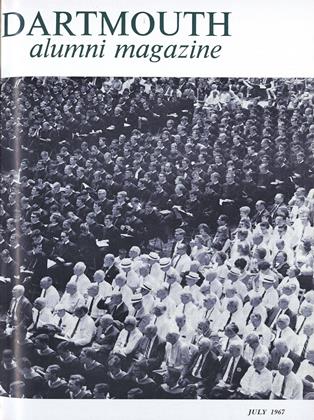By Robert O.Collins '54 and Robert L. Tignor. Englewood Cliffs, N.J.: Prentice-Hall, Inc.,1967. 180 pp. $4.95 ($1.95 paperbound).
Egypt and the Sudan is a short, successful summary and analysis of the modern history of two sister nations. The book emphasizes that the Sudan no less than Egypt is "the gift of the Nile" and that the great river itself is the constant that always has linked the destinies of the two countries.
The authors present their story in a context that relates a variety of environmental and geographic realities as well as premodern events to current happenings. But the work does exhibit a unifying theme: that the events that enliven the recent history of the Nile valley are only symptomatic of a complex, underlying contest between forces representing continuity - the old — against those championing change - the new. This battle between traditionalism and modernism still rages today in post-revolutionary Egypt and post-independent Sudan. Despite the seeming pervasiveness of nationalist and revolutionary fervor millions in both nations - probably the majority of the populace within the two states - still give ultimate loyalty to attitudes, expectations, and practices more attuned to Pharaonic times than to the second half of the twentieth century.
Ail in all, the writers have used admirable judgment and emphasize topics that clarify rather than obscure the major trends is Egyptian and Sudanese history. Moreover, their judicious use of factual materials illustrates these movements well. Two sections of the work are particularly interesting. The pages detailing the gensis and early progress of the 1952 Egyptian revolution indicate that the revolutionaries were far less guided by radical ideological notions than often is supposed. Equally arresting is the substantial chapter treating the time of British dominance in the Nile valley. Because they are both specialists on the period, the authors are especially convincing when dealing with the recent colonial past. Their remarks on the subject stand as the synthesis of a great deal of research and reflection on the original sources.
Egypt and the Sudan is written in an engaging style. It displays an overall unity that often is lacking in collaborations. It is a work that can be read pleasurably and profitably by scholars as well as by the literate general reader. Since it is available in an inexpensive paperback version, hopefully this fine little book will attract a large readership.
Associate Professor of History
 View Full Issue
View Full Issue
More From This Issue
-
 Feature
FeatureDartmouth Changing and Unchanged
July 1967 By DR. WALTMAN WALTERS '17 -
 Feature
FeatureEducation's Marshall Plan
July 1967 By ROBERT H. WINTERS, LL.D. -
 Feature
FeatureCouncil Honors Four
July 1967 -
 Feature
FeatureReunions Draw Record Attendance
July 1967 -
 Feature
FeatureHONORARY DEGREE CITATIONS
July 1967 -
 Feature
FeatureCOMMENCEMENT 1967
July 1967
ROBERT G. LANDEN
Books
-
 Books
BooksRecent publications
NOVEMBER 1931 -
 Books
BooksALUMNI PUBLICATIONS
February 1939 -
 Books
BooksTHE PHENOMENOLOGY OF MORAL EXPERIENCE.
July 1955 By FRED BERTHOLD JR. '45 -
 Books
BooksHOGARTH ON HIGH LIFE. THE MARRIAGE A LA MODE SERIES FROM GEORG CHRISTOPH LICHTENBERG'S COMMENTARIES.
DECEMBER 1970 By JOHN HURD '21 -
 Books
BooksYOU NEED A COMPLETE REST
October 1953 By RADFORD C. TANZER '25 -
 Books
BooksTHE PLATFORM SCRIPTURE.
MARCH 1964 By ROBERT J. POOR




